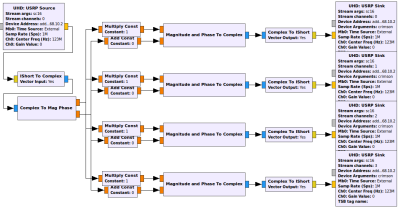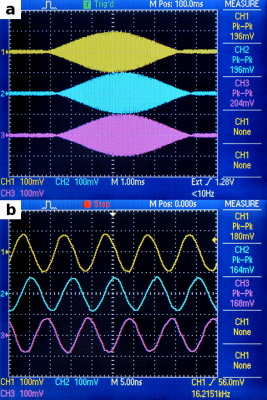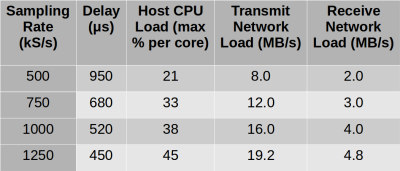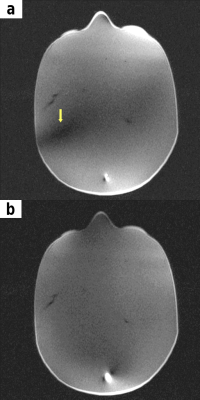1690
Software defined radio-based platform for parallel transmission MRI research1Physical Sciences, Sunnybrook Research Institute, Toronto, ON, Canada, 2Department of Medical Biophysics, University of Toronto, Toronto, ON, Canada
Synopsis
Parallel transmission (PTx) research platforms are challenging to implement and to integrate with commercial MRI systems. A prototype PTx research platform was demonstrated that leverages off-the-shelf software-defined radio (SDR) for flexibility and scalability, with easy integration and moderate cost. The SDR system was evaluated on the bench and connected to a commercial 3-T MRI system for an initial RF shimming demonstration. Substantial latency was found, likely due to the preliminary software implementation, but overall measurements and images were promising. Scaling to 32 transmit channels and applications other than RF shimming are expected to be practical.
Introduction
Parallel transmission (PTx), wherein radiofrequency (RF) power is applied via multiple independent transmission channels, is becoming increasingly important for MRI over a broad range of field strengths.1 Many research questions remain about how to optimize PTx hardware and applications. However, flexible PTx research platforms are challenging to implement and to integrate with commercial MRI systems. Software-defined radio (SDR), wherein a host computer system substitutes for dedicated RF electronics, has been driven by factors including decreased cost and availability of the GNU Radio framework for easy SDR programming. Low-field, single-channel MRI has been demonstrated using a low-cost, off-the-shelf SDR device.2 Based on these developments, the use of SDR for PTx merits investigation.
In the present work, a prototype PTx research platform is demonstrated that leverages off-the-shelf SDR for flexibility and scalability. The overall design goals were ease of integration, flexibility, and high performance at moderate cost. The platform was bench-tested for preliminary characterization of performance and scalability, and was also connected to a commercial 3-T MRI system for an initial demonstration of RF shimming capability.
Methods
A high-performance 4-channel Tx/Rx SDR unit (Crimson TNG, Per Vices Corp.) was chosen for the prototype. The SDR system’s dual 10Gb networking, and synchronization and triggering ports, should enable PTx research using potentially dozens of RF channels at magnetic fields ranging from 1.5 T to >7.0 T. For initial testing, one 4-channel SDR unit was driven by a legacy desktop computer (4-core Intel i5-2500, running Ubuntu Linux 16.04). A minimal RF shimming program was designed (Fig. 1). For preliminary bench testing, 100-MHz sinc pulses were supplied by an arbitrary waveform generator (AFG3102, Tektronix), and SDR outputs were recorded using an oscilloscope (TDS2024, Tektronix). The CPU and network utilization on the host computer were evaluated to assess scalability.
The SDR system was then interposed in the transmission chain of a 3-T MRI system (Prisma, Siemens Healthcare) in a way that minimizes the integration effort (covered in a separate submission but outlined briefly here): A custom coil plug adaptor intercepted the MRI system’s single-channel transmissions, allowing the signal to be processed by the SDR system, amplified, and sent into a custom Tx/Rx coil array. Four-channel PTx images of a head phantom were acquired using an unmodified gradient echo sequence.
Results
Figure 2 shows oscilloscope displays while running the RF shimming program. The system introduced a substantial time delay that decreased with increasing baseband sampling rate (Fig. 3). Host computer CPU and network load were also proportional to the sampling rate. Sampling rates greater than 1250 kS/s were not stable using GNU Radio, but vendor sample C++ programs transmitting on 4 channels were tested up to 50 MS/s with maximum CPU load of just 27% per core and transmit network load of 754 MB/s. Four-channel PTx MRI showed improved spatial uniformity with RF shimming (Fig. 4).
Discussion
Bench testing demonstrated acceptable qualitative performance. Phase and magnitude were similar across channels and stable during runs, but must be assessed in more detail using a network analyzer to implement appropriate corrections. Although easy to use and adapt, the buffering architecture of GNU Radio imposed sample rate limitations and is likely responsible for the observed timing delays. This suggests programming directly in C++ for performance reasons with higher channel counts, and relegating GNU Radio to prototyping with low channel counts. As a rough estimate by extrapolation, a C++ program at 10 MS/s and 32 transmit channels could run on ten or more CPU cores, and generate feasible network traffic totalling under 1250 MB/s. The total cost for eight of the tested high-end SDR units, a rack computer and cabling is approximately US$120,000, not including labour or MRI system connection hardware.
Furthermore, SDR provides an interesting, flexible platform for PTx research, enabling arbitrary handling of both receiver and transmitter channels in software. Initial static RF shimming results are shown, but the system permits broader capabilities. Dynamic RF shimming, possibly based on realtime monitoring via the SDR receiver channels, could be studied to compensate for patient or organ motion. SDR devices can also serve as a replacement RF pulse generator to enable arbitrary waveforms on each channel, as required for “full” PTx methods such as Transmit SENSE.3
Conclusion
An off-the-shelf SDR system produced encouraging initial results on the bench and during MRI. Development continues, particularly to reduce latency found in the prototype, but overall the system looks suitable to provide a platform for flexible, scalable, easily-integrated PTx research at moderate cost.Acknowledgements
Thanks to Soroush Ghomashchi for initial help with GNU Radio.References
1. Padormo F, Beqiri A, Hajnal JV, Malik SJ. Parallel transmission for ultrahigh-field imaging. NMR Biomed. 2016; 29: 1145-1161.
2. Hasselwander CJ, Cao Z, Grissom WA. gr-MRI: A software package for magnetic resonance imaging using software defined radios. J Magn Reson. 2016; 270: 47-55.
3. Katscher U, Börnert P, Leussler C, van den Brink JS. Transmit SENSE. Magn Reson Med. 2003; 49: 144–150.
Figures



